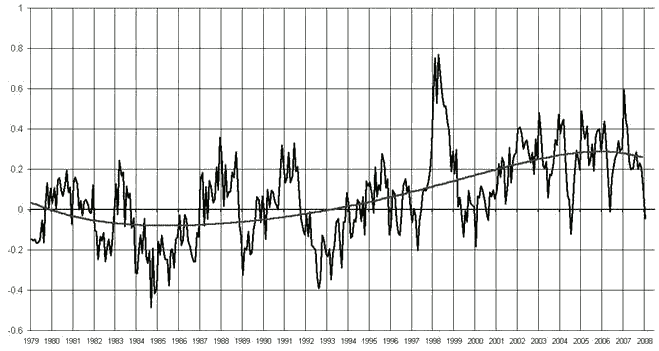A soprano thrillingly hits her top-A, sighs with relief at achieving the desired effect, and moves on. But not the Intergovernmental Panel on Climate Change (IPCC) whose climate alarmism started to crescendo in 2001 in the Third Assessment Report (3AR) with the statement that “most of the observed warming over the last 50 years is likely (>66 per cent probable) to have been due to the increase in greenhouse gas concentrations”.
Recently, in their Fourth Assessment Report (4AR), and faced with their failure to convince the public that the sky is falling, the IPCC delivers even more preposterous advice in ever shriller tones, saying that “Most of the observed increase in global average temperatures since the mid-20th century is very likely (>90 per cent probable) due to the observed increase in anthropogenic greenhouse gas concentrations”. The wobble around top-A is clearly discernible.
The press, most of whom have firmly identified with the alarmist cause, continues to appease the Green gods by faithfully running IPCC’s now unrealistic scientific propaganda, thereby stoking public alarm; the science is a done deal, they say, and the time has come to stop talking. According to UK journalist, Geoffrey Lean, all that is lacking to solve the global warming “crisis” is political will from governments.
Advertisement
Well, thank the Lord for that lack. For the IPCC’s 2007 final Summary for Policymakers shows that the climate alarmists are at last on the run. Their evidence for dangerous, human-caused global warming, always slim, now lies exposed in tatters for all to see.
In contrast, the alternative, persuasive and non-alarmist view of climate change is well summarised in two recently issued and readily available documents. The first is a letter to the Secretary General of the United Nations, which was released at the UN’s Bali conference last December, supported by the signatures of 103 eminent professional persons. The second is the Manhattan Declaration on Climate Change, the release of which coincided with the launch of the International Climate Science Coalition at a major climate rationalist conference in New York in early March.
The evidence for dangerous global warming adduced by the IPCC has never been strong on empirical science. Endless circumstantial scare campaigns have been run about melting glaciers, more droughts and storms and floods, sea-level rise and polar bears, but all founder on one inescapable problem - as does Mr Al Gore’s over-hyped science fiction film. And that is that we live on a naturally variable planet. Change is what planet Earth does on all scales, and so far not one of the alleged effects of human-caused global warming has been shown to lie outside normal planetary variation. Sea-level rising? Sure, it happens. And the appropriate response is adaptation, as the Dutch have known for centuries.
Stuck with the absence of empirical evidence for dangerous warming or abnormal change, in 2001 the IPCC turned to graphmanship, giving prominence in its 3AR to the so-called “hockey-stick” record of temperature over the last 1,000 years. The hockey-stick graphic, which appeared to show dramatic increases of temperature during the 20th century compared with earlier times, has now been exposed as statistical chicanery and, thankfully, is nowhere to be seen in the 4AR.
No hockey-stick and no empirical evidence, what is a man to do? Well, obviously, turn to virtual reality rather than real reality: PlayStation 4 here we come.
The IPCC’s expensive and complex computer models can be programmed to produce any desired result, and it is therefore not surprising that they uniformly predict warming since 1990. Meanwhile, the real-world global average temperature has stubbornly refused to obey this stricture. It exhibits no significant increase since 1998, and the preliminary 2007 year-end temperature confirms the continuation of a temperature plateau since 1998 to which is now appended a cooling trend over the last three years.
Advertisement
Is global cooling next?
“Best fit” of yearly average temperature
Lower atmosphere global temperature differences (degrees C) from 1979 - 1998 average

Discuss in our Forums
See what other readers are saying about this article!
Click here to read & post comments.
77 posts so far.